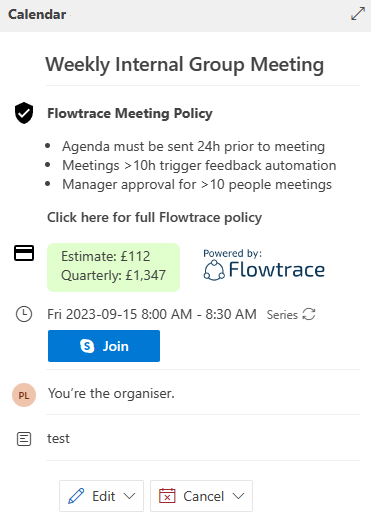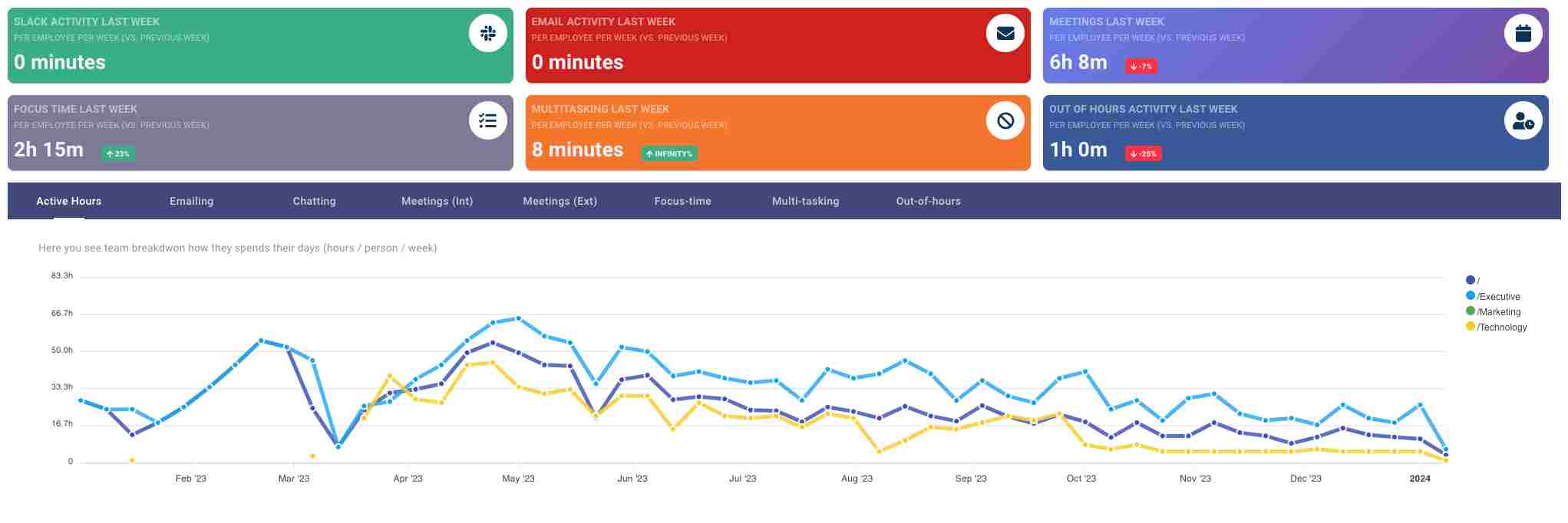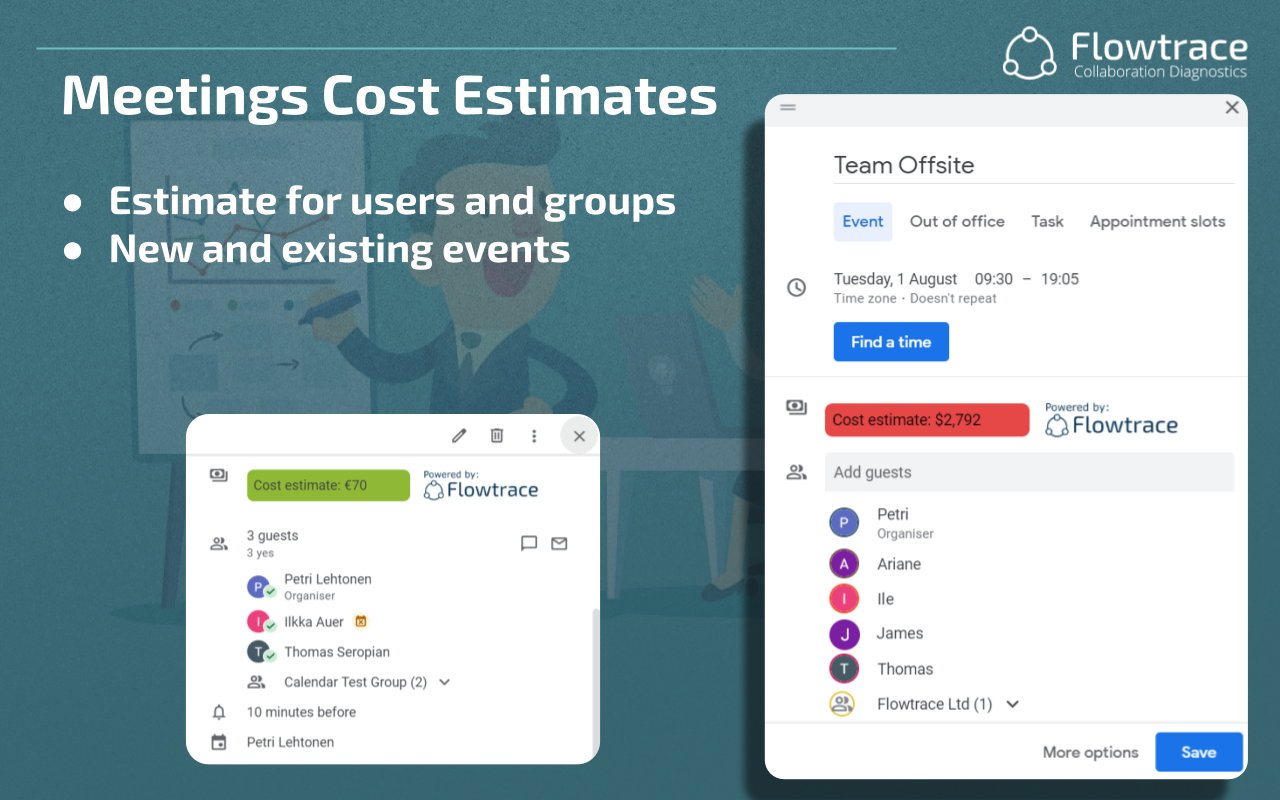Return on Investment (ROI) is a critical metric to evaluate the efficiency and effectiveness of various business operations, including meetings. Meetings are a significant investment of time and resources, meant for collaboration, decision-making, and strategic planning among teams.
Properly assessing the ROI of these meetings is essential to ensuring they contribute positively to the company's goals. The goal of measuring the ROI of meetings is to confirm that these gatherings drive operational efficiencies and align with strategic objectives, rather than serving as routine, resource-consuming events.

The Cost of Meetings
Meetings are integral to organizational communication and decision-making, especially considering they cost U.S. businesses approximately $37 billion annually, however, they come with both direct and indirect costs. Direct costs are more tangible and include expenditures on technologies for virtual conferencing, physical venues for in-person meetings, and necessary materials like handouts or multimedia equipment.
Indirect costs, though less visible, are significant; they include the allocation of employee time that could be spent on other productive tasks, as well as the opportunity costs of diverting resources and attention from core business activities.
To effectively manage and potentially reduce these meeting costs, organizations can benefit from using meeting cost calculators, like the one offered by Flowtrace. Such tools enable meeting organizers to see the estimated cost of meetings in real time when scheduling. By quantifying this aspect, leaders can make informed decisions about which meetings are essential and how to streamline meeting practices to enhance productivity while minimizing costs.

Using a meeting cost calculator helps in identifying patterns of inefficiency, such as frequent meetings that yield minimal actionable outcomes or high-cost meetings that do not align with strategic goals. With this data organizations can tailor their meeting schedules and formats to ensure that every meeting is justifiable in terms of cost versus benefit, leading to more strategic resource allocation and a better return on investment for the time spent in meetings.
The ROI of Effective Meetings
Increased Productivity
Measuring the ROI of meetings through increased productivity involves several aspects. Productivity can be enhanced by ensuring meetings are well-structured and outcome-oriented. This entails having a clear agenda, defined roles, and a follow-up process to ensure that decisions made during meetings translate into actions. Reducing the frequency of meetings can contribute to increased productivity by freeing up time for employees to engage in deep work without interruptions.
By analyzing meeting patterns and productivity metrics, Flowtrace helps leaders identify how meetings impact work output. This provides insights into the correlation between meeting frequency and team productivity levels, enabling leaders to adjust schedules to maximize efficiency. For example, if teams have back-to-back meetings and are showing diminished productivity - it could suggest there are too many meetings.

Reduced Cost of Meetings
Effective meetings not only enhance productivity but also lead to substantial cost savings. By optimizing the number and length of meetings, organizations can significantly reduce the hours spent in non-productive meetings, thereby cutting down on the hidden costs associated with them.
Using a tool such as the Flowtrace meeting cost calculator can identify these costs and empower leaders to reduce unnecessary meetings to avoid financial implications.

Let's consider various scenarios to illustrate potential savings from optimizing meeting structures:
Scenario 1: Standard Team Meeting
- Frequency: Weekly
- Duration: 1 hour
- Number of Participants: 6
- Cost per Hour per Person: £80
- Annual Cost: 1 hour/week×52 weeks/year×6 participants×£80=£24,960
Scenario 2: Extended Project Meeting
- Frequency: Weekly
- Duration: 2 hours
- Number of Participants: 10
- Cost per Hour per Person: £80
- Annual Cost: 2 hours/week×52 weeks/year×10 participants×£80=£83,200
Scenario 3: Brief Check-In
- Frequency: Weekly
- Duration: 30 minutes
- Number of Participants: 4
- Cost per Hour per Person: £80
- Annual Cost: 0.5 hours/week×52 weeks/year×4 participants×£80=£8,320
These examples demonstrate how the frequency, duration, and number of attendees can impact the financial overhead associated with meetings. Flowtrace can help organizations conduct such analyses and make informed decisions about optimizing meeting practices to reduce unnecessary expenditures while maintaining or enhancing the productivity and effectiveness of meetings.

Improved Employee Engagement and Collaboration
Enhanced employee engagement and collaboration are significant indicators of the ROI from effective meetings. When meetings are interactive, well-planned, and inclusive, they foster a sense of belonging and commitment among team members, which in turn boosts morale and productivity.

This allows leaders to make adjustments that encourage more active involvement and collaboration, ensuring that meetings are productive sessions where ideas flow and everyone feels valued.
Better Outcomes and Follow-Up Actions
Effective meetings lead to clear, actionable outcomes, reducing the need for follow-up meetings. When objectives are met and tasks are clearly assigned during initial meetings, teams can move forward with implementation rather than revisiting discussions.
This can be achieved by efficient meeting planning, having a structured agenda, following meeting best practices, and collecting feedback. Utilizing Flowtrace meeting analytics, leaders can identify meetings without an agenda and collate feedback directly in Slack.
Tracking Decision-Making Speed
The speed of decision-making within meetings can significantly impact an organization’s agility and efficiency. Fast and effective decision-making processes suggest a high level of clarity and preparedness among participants, which can be critical in fast-paced business environments.
By analyzing meeting and productivity data, Flowtrace can support highlighting bottlenecks or delays in decision-making, allowing leaders to address these issues directly, perhaps by improving agenda setting, ensuring the right stakeholders are present, or providing better preparatory materials ahead of meetings.
Participant Satisfaction Scores
Measuring participant satisfaction through post-meeting surveys is a direct method to gauge the perceived effectiveness and value of meetings. These surveys can assess various aspects such as the relevance of topics discussed, the effectiveness of the meeting facilitator, and the overall meeting environment. High satisfaction scores typically indicate that meetings are well-structured and fulfill their intended purposes, contributing positively to team dynamics and project progress.
Flowtrace can integrate these surveys and present the data insights, helping leaders continuously improve the quality of their meetings based on direct feedback from participants.
Meeting Attendance Rates
Monitoring attendance rates over time provides valuable insights into how employees perceive the value of meetings. Increasing attendance rates often suggest that meetings are considered useful by team members, while declining rates may indicate issues with meeting relevance, timing, or execution.
Flowtrace can identify meeting frequency and time spent in meetings, offering a clear picture of trends that leaders can use to adjust meeting practices, enhance engagement, and ensure that meetings are seen as worthwhile by all participants.

Post-Meeting Execution Rate
One of the most tangible indicators of meeting effectiveness is the rate at which planned actions are implemented post-meeting. A high execution rate suggests that meetings are successful in driving actions and achieving goals, whereas a low rate may point to issues in clarity, commitment, or follow-through.
Quality of Decisions
Evaluating the quality of decisions made during meetings is crucial for understanding their impact on key business outcomes, such as revenue growth, cost savings, or project success. This assessment involves looking at the long-term effects of these decisions and how they contribute to the organization’s strategic goals.
Meeting Lead Times
The efficiency of meeting preparation, including scheduling and planning, is another critical aspect of meeting management. Measuring the time taken to prepare for meetings can reveal improvements or needs in process efficiency. Shorter lead times combined with effective outcomes can indicate a high level of organizational agility and preparedness.
Together, these metrics form a comprehensive way of assessing the ROI of meetings, ensuring that each gathering is purposeful and productive. By leveraging meeting analytics from Flowtrace to monitor and analyze these factors, organizations can optimize their meeting practices, leading to better decision-making, improved team engagement, and more effective execution of business strategies.
Drive Meeting Efficiency Today
Measuring the ROI of meetings is essential for organizational success, encompassing factors like productivity, engagement, and decision-making effectiveness. Flowtrace offers a solution to optimize this process, providing insightful analytics to optimize meeting structures and outcomes. Try it for yourself and improve your meeting culture.
